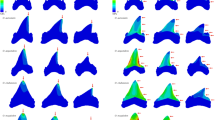Summary
A rich engineering literature exists that is applicable to many aspects of vertebrate jaw mechanics and has been referred to in many studies in this sector. But mechanical engineering technology has provided few theoretical bases that are directly helpful in the study of predator teeth. Hence, analyses of puncturing and slicing functions of these teeth have lacked a firm physical technology as a background. Predator teeth have evolved to pierce and cut animal tissues that are usually compliant in that they readily undergo relatively large deformations under applied stress before they actually yield. The bulk of engineering theory is directed toward such noncompliant materials as wood and metal, the design of tools that cut them, and the mechanics involved in this. The purpose of the present paper is to scan the mechanical implications of different tooth designs, pose hypotheses that relate to primary considerations of the physics of cutting compliant substrates, and offer a preliminary approach that is intended as a useful guide to further studies on sharks and on other vertebrate groups. Thus, in this paper I have attempted to formulate some tentative and preliminary generalizations concerning the mechanics of cutting compliant materials. Then comes a survey of the teeth of a particular group of predators, three families of sharks, in terms of these preliminary formulations. The approach views the shark teeth in isolation from the complex cranial mechanism (presently under study) that functionally integrates with the teeth. Therefore, adaptive conclusions are minimal, because the evolutionary significance of tooth form cannot properly be assessed outside of an integrated study. However, certain correlations do exist between structural tooth characteristics and mechanics. Slender, smooth-edged (or nearly so) teeth can readily pierce prey, but are of less use in slicing it. Such teeth are typical of the lower jaw dentition in many sharks and, in a few species, they are present in both upper and lower jaws. Usually these slender teeth display a reversed curvature at their tips, so that although most of the tooth's crown is curved inward toward the mouth cavity, the tip is turned outward. This outward turning of the tip can enhance the probability of initial prey penetration, without much compromising the prey-retaining properties of the inward curvature of the greater, more proximal portion of the tooth. Many sharks possess upper teeth with serrations along the edges. The serrations vary from one species to another in coarseness and in distribution along tooth edges. Serrated teeth can make greater use of the available biting forces, and they have a greater cutting effect than do smooth-edged teeth. These latter depend upon friction which, because the coefficient friction is always less than 1.0 (often very much less), can make use of only a fraction of the total bite force. However, smooth tooth blades can pierce prey with less resistance and are less prone to binding (becoming immobilized) in the prey tissue. In many shark species serrations are concentrated along the proximal portions of the tooth crown, where the bases of adjacent teeth are in near contact along the jaw margin. In these regions food can be pressed during feeding, resulting in a binding of the teeth in the prey. Release of the binding must be accomplished by cutting the jammed food, to permit clearance of the prey material so it can slip past the tooth rows. The more prominent serrations in such regions may act to puncture and slice the jammed tissue. It is noted that commercial saws are typically designed in various ways to promote clearance between adjacent saw teeth. The pitch or rake of the teeth of sharks is discussed, as is the overall form of the tooth rows along the jaw margins. The relationship between the distribution of teeth along the jaw margins and surface irregularities of the prey surfaces is also considered.
Similar content being viewed by others
References
Barkas WD, van Rest ED, Wilson WE (1932) The principles of woodworking. H.M. Stationery Office, London
Bigelow HB, Schroeder JWC (1948) Fishes of the Western North Atlantic. Yale University Press, New Haven (Memoirs of the Sears Foundation, part 1: Marine research)
Compagno LJV (1984) Sharks of the world. FAO species catalog: FAO fish synopsis No. 125, vol. 4 pts 1 and 2. United Nations Develop Prog, Rome
Durham HW (1917) Saws: their treatment and care. Van Nostrand, New York
Frazzetta TH (1966) Studies on the morphology and function of the skull in the Boidae (Serpentes): II. Morphology and function of the jaw apparatus in Python sebae and Python molurus. J Morphol 118:217–296
Frazzetta TH, Prange CD (1987) Movements of cephalic components during feeding in some requiem sharks (Carcharhiniformes: Carcharhinidae). Copeia 4:979–993
Prindle B, Walden RG (1976) Deep-sea lines fishbite manual. Natl Ocean Atmosph Admin, Natl Data Buoy Office, Bay St. Louis, Mississippi
Author information
Authors and Affiliations
Rights and permissions
About this article
Cite this article
Frazzetta, T.H. The mechanics of cutting and the form of shark teeth (Chondrichthyes, Elasmobranchii). Zoomorphology 108, 93–107 (1988). https://doi.org/10.1007/BF00539785
Received:
Issue Date:
DOI: https://doi.org/10.1007/BF00539785




